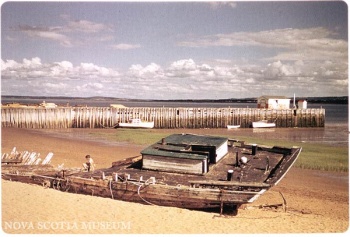Dominion Atlantic Railway Digital Preservation Initiative - Wiki
Use of this site is subject to our Terms & Conditions.
Difference between revisions of "Kingsport Wharf"
Dan conlin (talk | contribs) (image placement) |
Dan conlin (talk | contribs) (more info and sources) |
||
| Line 1: | Line 1: | ||
==[[Kingsport]] Wharf== | ==[[Kingsport]] Wharf== | ||
[[Image:Kingsportwharfa.jpg|thumb|right|350px||The [[Kingsport Wharf]], circa 1960, showing the second DAR freight shed, now boarded up in the last days of the subdivision.]] | [[Image:Kingsportwharfa.jpg|thumb|right|350px||The [[Kingsport Wharf]], circa 1960, showing the second DAR freight shed, now boarded up in the last days of the subdivision.]] | ||
| − | Built in several stages, this pile and cribwork wooden wharf at [[Kingsport]] | + | Built in several stages, this pile and cribwork wooden wharf at [[Kingsport]] reached 850 feet in length by 1912. It was 40 feet wide for its entire length and 22 feet high at the end.(1) The wharf was owned by the Canadian federal government but leased by the DAR for a spur line which ran the entire length of the wharf along the east side. Kingsport trains used the wharf daily in the summertime to connect to DAR steamers such as [[SS Prince Albert]] and the [[MV Kipawo]] as well as occaisional large cargo steamers and coastal schooners. Boxcars and flatcars were often spotted on the wharf and left to deliver or receive specific freight when ships were expected. |
The wharf spur ended beside the wharf lighthouses at the tip. A wooden post jib crane located halfway along the wharf was used to load and unload railway cars. A dismounted DAR boxcar first served as a freight shed. It was replaced in 1927 by a combined DAR freight shed and passenger shelter built for the introduction of the [[MV Kipawo]]. The shed and lighthouse were destroyed in a fire in 1947. A second DAR shed was built on the wharf after the fire. When rail service ended in 1961, the freight shed was moved into the village and converted to a cottage. The wharf continued to be used by small fishing craft until the early 1970s but gradually collapsed. In 2003, the stub of the wharf was stabilized as a lookoff and boat ramp and the remaining ruins were demolished. | The wharf spur ended beside the wharf lighthouses at the tip. A wooden post jib crane located halfway along the wharf was used to load and unload railway cars. A dismounted DAR boxcar first served as a freight shed. It was replaced in 1927 by a combined DAR freight shed and passenger shelter built for the introduction of the [[MV Kipawo]]. The shed and lighthouse were destroyed in a fire in 1947. A second DAR shed was built on the wharf after the fire. When rail service ended in 1961, the freight shed was moved into the village and converted to a cottage. The wharf continued to be used by small fishing craft until the early 1970s but gradually collapsed. In 2003, the stub of the wharf was stabilized as a lookoff and boat ramp and the remaining ruins were demolished. | ||
At one time a siding was located on the wharf, but it was removed by 1911. | At one time a siding was located on the wharf, but it was removed by 1911. | ||
| + | |||
| + | ==References== | ||
| + | (1) * Plan of Wharf, Public Works Canada, June 12, 1942, Leon Barron Collection. | ||
| + | *[http://museum.gov.ns.ca/imagesns/html/20015.html Nova Scotia Museum photograph of wharf, circa 1960] | ||
[[Category:Wharves]] | [[Category:Wharves]] | ||
Revision as of 15:52, 3 January 2009
Kingsport Wharf

Built in several stages, this pile and cribwork wooden wharf at Kingsport reached 850 feet in length by 1912. It was 40 feet wide for its entire length and 22 feet high at the end.(1) The wharf was owned by the Canadian federal government but leased by the DAR for a spur line which ran the entire length of the wharf along the east side. Kingsport trains used the wharf daily in the summertime to connect to DAR steamers such as SS Prince Albert and the MV Kipawo as well as occaisional large cargo steamers and coastal schooners. Boxcars and flatcars were often spotted on the wharf and left to deliver or receive specific freight when ships were expected.
The wharf spur ended beside the wharf lighthouses at the tip. A wooden post jib crane located halfway along the wharf was used to load and unload railway cars. A dismounted DAR boxcar first served as a freight shed. It was replaced in 1927 by a combined DAR freight shed and passenger shelter built for the introduction of the MV Kipawo. The shed and lighthouse were destroyed in a fire in 1947. A second DAR shed was built on the wharf after the fire. When rail service ended in 1961, the freight shed was moved into the village and converted to a cottage. The wharf continued to be used by small fishing craft until the early 1970s but gradually collapsed. In 2003, the stub of the wharf was stabilized as a lookoff and boat ramp and the remaining ruins were demolished.
At one time a siding was located on the wharf, but it was removed by 1911.
References
(1) * Plan of Wharf, Public Works Canada, June 12, 1942, Leon Barron Collection.